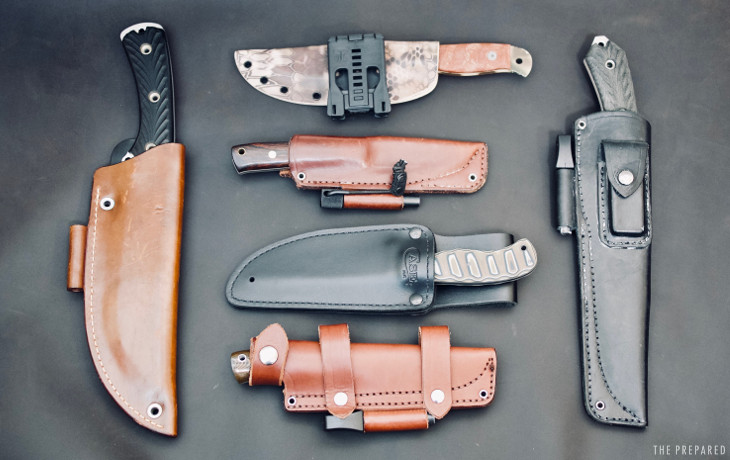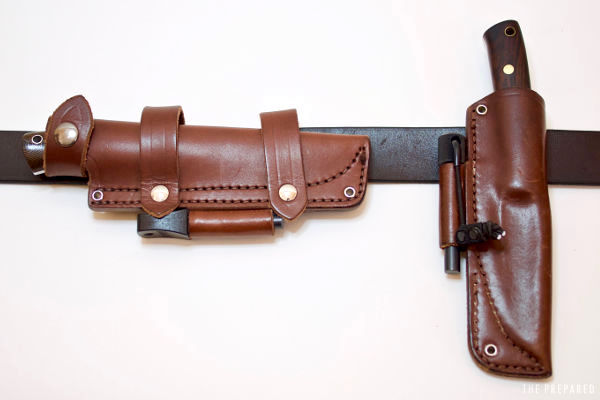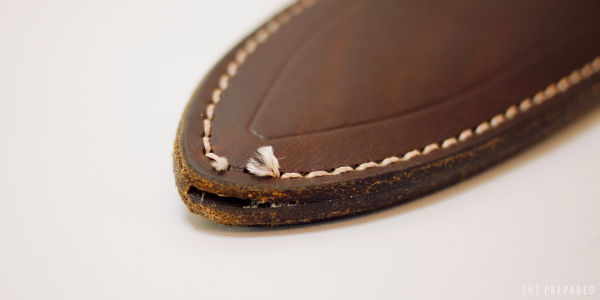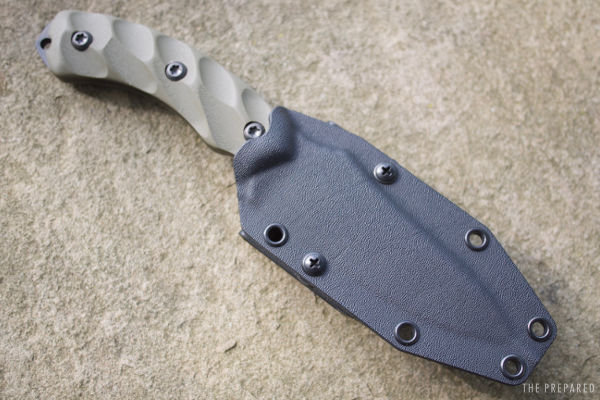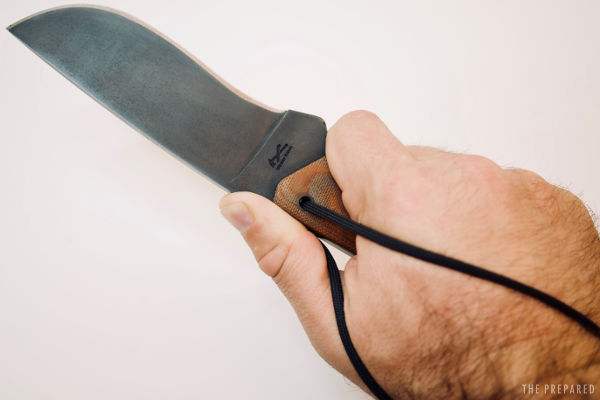The knife itself is only part of a good field knife setup, because a knife is not really usable without a proper sheath and a way to keep the edge sharp.
Most quality knives — including almost all of the models recommended in the best survival field knife review — come with a synthetic factory sheath that’s good enough for most people. No aftermarket upgrade needed.
For example, the >$100 ESEE blades come with a Kydex sheath that’s perfectly acceptable for average preppers (and is used as the primary blade and bug out bag sheath by one of our writers).
But some of the <$50 knives come with a sheath that we wouldn’t want to rely on in an extended emergency. It’s also not uncommon to see higher-end manufacturers include a factory sheath not good enough for prepping because they assume experienced buyers will replace it anyway.
However, if you’re buying a less-expensive knife and worry about the sheath quality, it’s usually a much better idea to just buy a better knife to begin with. Instead of spending $40 on a knife that comes with a cheap factory sheath and another $30 on a proper sheath, just spend $70 on a better knife and it’ll likely come with a sheath that’s good enough.
This isn’t a normal gear comparison review because the sheath depends on the knife model and personal preference. Instead, we explain when you would want to buy an aftermarket sheath, theory and criteria, and offer some suggestions for the most popular models.
Summary:
- You’ll want to consider where and how you’ll mount the sheath (belt, pack, horizontal, etc.)
- Try not to store your knife in a sheath — it can lead to rust and a dull blade
- Do not ever store a knife in a leather sheath because leather holds moisture and the chemicals used in tanning can corrode a blade
- Synthetic materials (like Kydex) are best for most people, while experienced users might prefer leather
- Wrist lanyards are actually worth using, and paracord is superior to leather
- Avoid complicated sheaths with “survival kits” attached
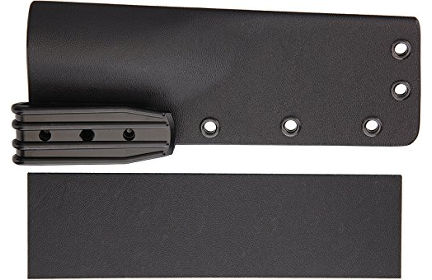
Make your own:
Armory Plastics DIY Kydex Sheath
Kydex is popular in part because you can buy a simple kit and make your own sheath at home. You wrap heated Kydex around the knife, hold/press until it cools, and you’re done. It’s easy to assume that DIY methods create sheaths that are less-awesome than the off-the-shelf models, but in reality we’ve found that it’s not hard or expensive to make a DIY Kydex sheath that compares favorably with an off-the-shelf sheath, so it’s simply a matter of choice.
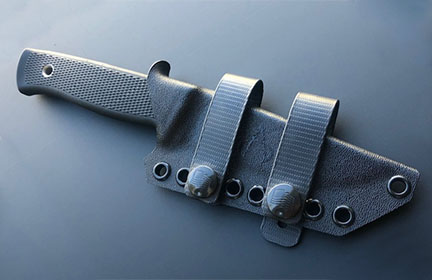
Great for the F1:
Armatus Fallkniven F1 Kydex Sheath
Many people who buy our top choice knife, the Fallkniven F1, replace the factory sheath with a more durable leather or Kydex sheath. It’s such a popular knife that you’ll find a wide range of options, including many custom leather craftsmen who aren’t easy to find online. For example, you can email JRE Industries and they’ll take good care of you — they even made our 2018 Christmas prepper gift guide — or pick from this list of Patriot Leather designs.
Sticking with our recommended Kydex material, Armatus offers a $50 Fallkniven F1 Sheath in a variety of colors. This fully ambidextrous sheath also includes a pair of laminated nylon soft loop with mil-spec Pull-the-Dot™ snaps.
Be prepared. Don’t be a victim.
Want more great content and giveaways? Sign up for The Prepared’s free newsletter and get the best prepping content straight to your inbox. 1-2 emails a month, 0% spam.
Qualities of a good prepper knife sheath
There are two main factors to consider: material and carry method. Material is an objective choice, while carry method is more personal.
Additional criteria:
- Tough, durable, well-built
- Securely holds the knife so it won’t pop out
- Can be carried or mounted in ways that make sense for emergencies (e.g. can strap it to the outside of a bug out bag)
- Minor: Doesn’t create a lot of noise when moving the blade in or out or when bouncing against other gear
- Bonus: Some sheaths have extra pockets for things like sharpening stones or fire starters
Carry methods
You’ll carry your field knife attached to one of three places: your waist, chest, or pack.
That’s it. Despite how G.I. Joe drop-leg sheaths and boot knives look, these carry methods are not suitable for a primary field knife.
There are three options for waist carry:
- Belt carry: The standard method with the knife held vertically, tip down.
- Horizontal carry: Some bushcrafters like to carry their knife behind their back in a horizontal sheath. This keeps the knife out of the way, freeing up hip space on the belt for other gear. It also greatly aids in concealment, which, depending on what sort of social situation you find yourself in, could matter quite a bit.
- Inside waistband carry: An under-appreciated carry method that works very well for large knives is to tuck the knife and sheath inside the waistband on the hip. You can conceal very large fixed-blade knives this way, though accessibility and speed are hindered.
Chest carry is great when you want to keep the knife handy but off your limited belt space. It’s also compatible with most backpack straps and vests.
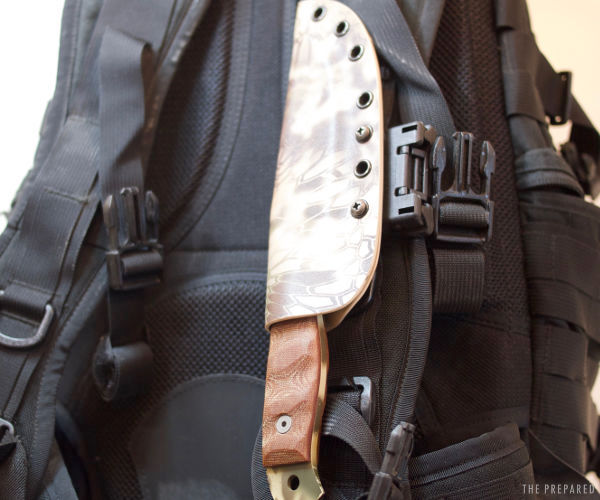
You may have noticed modern military movies that show a blade held upside down near the soldier’s left armpit (an area that doesn’t hold much gear anyway). The soldier can quickly grab and pull with their right hand, even when tied up in close-quarters fighting.
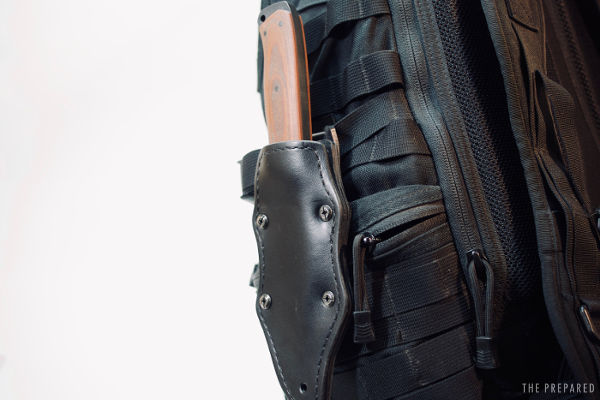
Although every piece of gear carried in an emergency bag is important, the field knife is one of those items you’ll use often and want relatively-quick access to. So if you don’t carry on your body, try strapping the knife to the outside of your pack instead of burying it beneath your underwear.
You’ll need a sheath with some holes in it that will enable you to securely lash it to your pack with cordage. If possible, lash the sheath in a spot that’s accessible without taking off the pack. Some sheaths can hold a knife securely while upside-down, so you can even mount the sheath at weird angles or on the flat bottom of a pack.
Ride height
Other than choosing where to attach your sheath, if you buy an aftermarket sheath you may also consider the ride height and if the sheath attaches with loops, clips, or cordage.
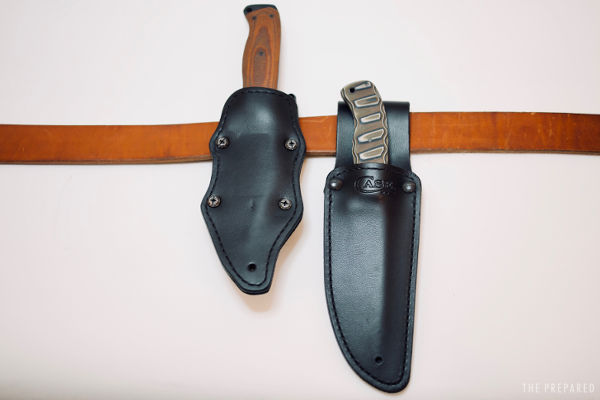
Bushcrafters tend to prefer a sheath where the knife handle is mostly above the belt line because this makes for fast, ready access. More tactical users, who may be carrying a belt-mounted pistol and wearing a load-bearing vest or armor carrier, tend to prefer a lower ride height so the blade handle is secondary to the pistol and won’t limit bending-over movements.
Attachment methods
Belt loop attachment methods are the most secure. Which, of course, means they’re the hardest to remove. Sheaths designed for belt loops are usually harder to strap to a vest or pack, as well.
Clips are less secure but more easily removable. For example, you may want to quickly move the sheath from your 2 o’clock position to your 5 o’clock. A clip makes that easy, whereas a loop-based sheath will require at least a partial removal of your belt.
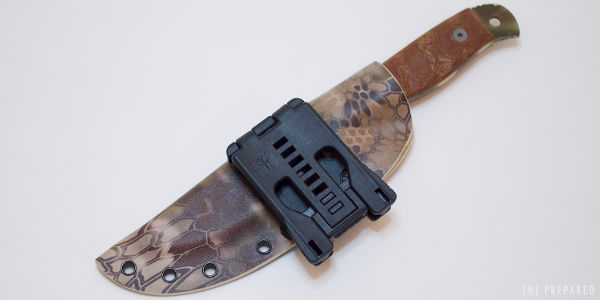
There are some specialty clip designs, like Tek-Lok, that try to combine the security of a loop with the flexibility of a clip.
Steel hates moisture and corrosive chemicals
Knives are made of steel, which rusts and corrodes when it sits in moisture and harmful chemicals.
Yet it’s unavoidable that a knife used during an emergency will be exposed to moisture and other chemicals found in our world. Even something simple like chopping wood will expose the blade to the natural moisture found in all but the most dried-out wood. If you’re chopping up processed wood, like an old piece of furniture or decking, then the knife is exposed to the varnish and treatments used as well.
Tip: Learn how to properly oil and repair your knife and it’ll last a lifetime!
It’s not uncommon to hear experienced knife users talk about how surprised they were at how quickly a blade will rust. We’ve personally left a blade in the car for a week after a camping trip, only to be shocked to see how much rust developed from so little moisture.
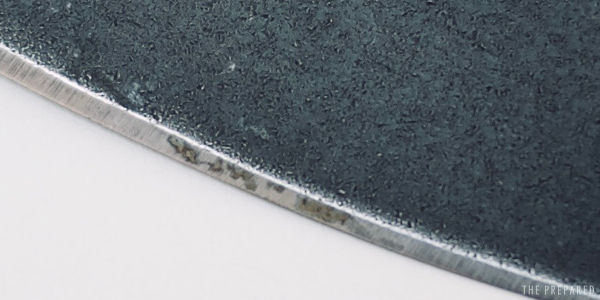
Even though most modern blades have a protective coating or metal treatment that inherently resists corrosion, the very edge of the blade itself is often exposed, especially after it’s been sharpened once or twice.
Sheath materials
Sheaths for field knives generally come in three main materials: leather, plastic (usually in the form of Kydex), and nylon. Each material has its pros and cons.
In the end, we recommend synthetic materials (namely Kydex) for people who just want an easy set-and-forget approach. Leather may be better for advanced bushcrafters who will use (and care for) their field knife often enough to overcome leather’s inherent disadvantages or for those who specifically care about noise reduction.
Leather
Leather is a very good, time-tested material that experienced field knife users love and recommend. High-quality leather has a great combination of toughness, light weight, and structure (or stiffness). It can also be repaired in the field, if need be, with the proper materials.
The other big benefit of leather, and a primary reason you see it in tactical knife sheaths that are designed for military use, is “noise discipline”. That’s a tactical cool-guy way of saying that leather is a lot quieter than harder synthetic materials. Drawing the blade is quieter, and leather won’t bang around against other gear on your body or pack.
You will probably never be in a situation where sheath noise is critical — but if you are, it really matters.
One big downside to leather is durability. Prolonged exposure to the elements will break down leather over time, just like a sun-beaten living room sofa. But there are plenty of products on the market to help and the maintenance isn’t overly complicated or burdensome.
Another big downside is safety with large or extremely-sharp knives. A cheap sheath with poor stitching and materials can easily end up like this:
Finally, you can never store a knife in a leather sheath. Leather holds moisture, and most leather sheaths have been treated with tanning and dyeing chemicals, all of which will corrode your blade.
Kydex
Kydex is the main alternative to leather. This plastic material’s main benefits are stiffness, durability, and low cost. It’s also safe to store your knife in a Kydex sheath for long periods of time, particularly if the blade is cleaned and coated with silicone or some oil that keeps moisture away.
A big downside to Kydex is that it’s loud — a Kydex sheath can rattle against other hard items in your kit, and it’s difficult to draw a blade quietly from it.
The other complaint people have about Kydex is that it can mar a knife blade and/or dull an edge if the sheath is designed poorly. And if sand or grit gets into a Kydex sheath, it can lodge in the wrong spot and scrape against the blade as it goes in and out, damaging the finish. Of course, finish damage can be less of an issue with the kinds of modern coatings found on most carbon steel blades, but it’s still worth considering.
Many popular knife models come with molded plastic options that are similar in most ways to Kydex, though they’ll often be proprietary and have different names. Everything said here about Kydex applies to these sheathes, as well.
Nylon
Nylon is another popular material, but we’re not fans of it. A nylon sheath lacks stiffness and structure, which makes it more likely that the blade will bend in some odd way and cut through the sheath.
Nylon sheaths can also retain grit in the fibers, and then they have the same blade-damaging problem as Kydex.
Don’t get crazy with sheath accessories
There are some higher-end bushcraft sheaths on the market that sport all sorts of holders, pockets, and straps, so that you can have an all-in-one survival kit bundle on your belt.
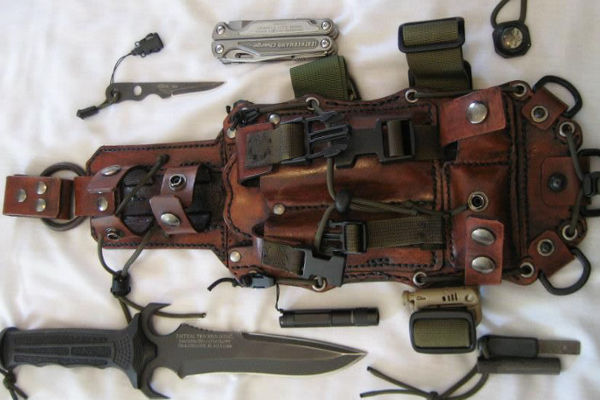
We’re not fans of this approach because if you lose that bundle then you’ve lost your kit. It’s also bulky and makes concealment more difficult.
It’s fine to get a sheath with loops or pockets for small sharpening stones or fire starting materials. But don’t get too fancy with the sheath attachments — less is generally more in this case.
But don’t overlook lanyards
A field knife wrist lanyard is actually worth using because it increases retention and safety while reducing fatigue. Lanyards are useful enough that we consider them part of the total knife system.
Imagine you’re without heat in a winter emergency and need to chop some furniture into firewood. A good field knife can do that, but you’ll feel muscle fatigue more quickly than with a proper axe.
Similar to ski poles with wrist straps, a knife lanyard lets you relax your grip on the blade without worrying about it flying out of your hand and spearing your favorite child.
That small amount of relaxation may not seem like much, but you’ll notice a difference after even just 15 minutes of work — let alone the added safety of not creating a medical problem at the worst possible time.
The vast majority of knives with lanyard holes have the attachment point at the bottom of the handle. Higher-end knives often have a lanyard hole at the front of the knife, right under the blade.
A lanyard placed through the top hole and looped around the wrist makes it easier to repeat the kinds of long, sweeping, away-from-the-body cutting strokes that you’d use to, say, sharpen a stick into a spear. The lanyard creates a pivot point that enables you to trade grip strength for wrist strength, so that you can use less wrist and more grip to do the same stroke.
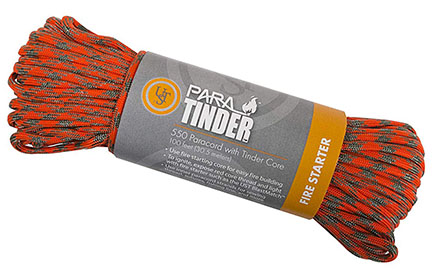
Simple lanyard improvements:
UST ParaTinder
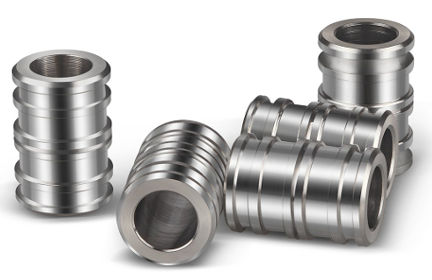
Simple lanyard improvements:
TI-EDC 14mm lanyard beads
The most popular lanyard material for field knives is good old 550 paracord. If you really want to max out this prep, pick the $6 UST ParaTinder, which contains an inner strand of flammable material that can be used to start a fire. We absolutely recommend good paracord over leather, the other popular lanyard option, because leather will stretch and hold moisture. Leather straps look great and can be fine in daily life, but not for a survival knife.
You’re also going to need a lanyard bead so that you can adjust the lanyard for different circumstances. Titanium lanyard beads are cheap enough that it’s worth picking up a box. We like these larger TI-EDC beads for knife lanyards; more length (14mm vs. 10mm for the shorter ones) means more surface area and friction in contact with the paracord, and a tighter hold.
Storage
Experts will tell you to never store a knife in its sheath. But we know that, in practice, many people (including some of our writers) just want to keep the knife in the sheath as part of their emergency bags.
Leather sheaths are the worst for storage, not just because of moisture retention, but due to chemicals used in the tanning process that aren’t kind to knife blades.
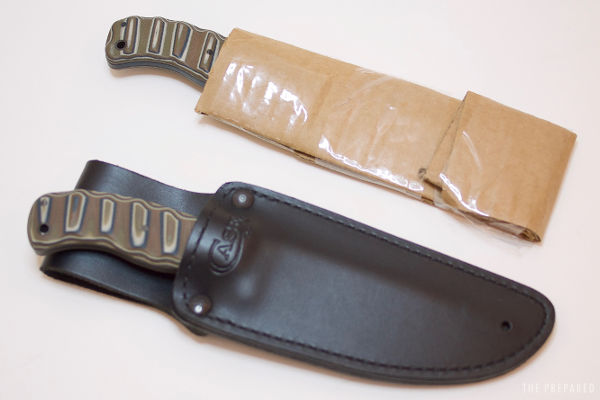
A cheap alternative is to make a simple sheath out of a piece of folded cardboard and some tape. Some of the custom or high-end knife manufacturers even package and ship their blades this way. The cardboard breathes enough to allow moisture to escape while keeping the edge protected.
If you do store your knife in a synthetic sheath, you can mitigate the problem by applying some oil or silicone as part of your general maintenance.
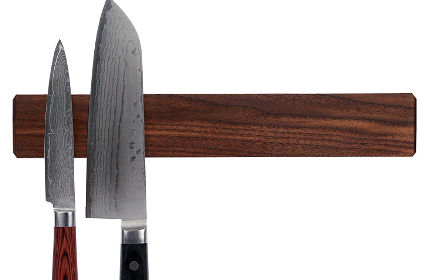
Beautiful, safe storage
Kurouto Kitchenware Walnut Knife Block
The very best field knife storage method is a wooden magnetic knife holder of the type that chefs use. These holders will store your knives safely without scuffing them, and they double as a display. We like the $35 Kurouto Kitchenware Walnut Knife Block for its combination of style, price, and five-star rating.
